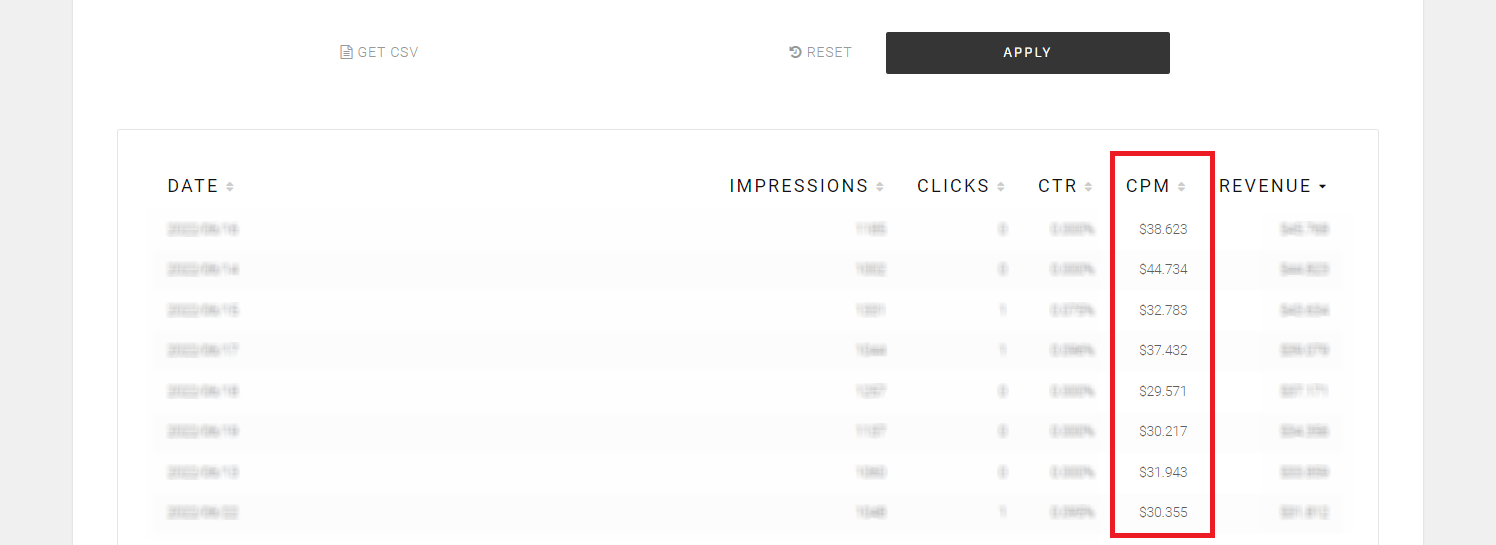What is eCPM definition for publishers? In bare outlines, it shows how much money you earn per 1,000 ad impressions and gives valuable insight into your website performance. But how can you apply it to grow your earnings?
This guide will lay out an effective way for publishers to measure ad performance. You will learn how to calculate eCPM, what a good eCPM is and how it differs from the traditional “cost-per-mille” metric.
What is eCPM for publishers? Definition and specifics
By design, eCPM allows publishers to see how profitable their websites are, as it counts earnings from digital ads.
The abbreviation stands for “effective cost per mille,” (mille = 1000 impressions) and the key word is “effective.” It helps website owners estimate how much they earn from every 1,000 ad impressions or how effective their monetization is.
It’s a critical metric in digital advertising. It focuses on earnings from ads, no matter if they come from ad impressions, clicks, or conversions. Basically, it considers all ad revenues and divides them between the total number of impressions.
Why is eCPM Important?
This is more visual and useful. CPM measures the final cost that an advertiser pays for every 1,000 impressions of their ad. eCPM measures the effective cost per thousand impressions of an ad, taking into account all possible sources of income (for example, clicks). Thus, eCPM focuses not only on the number of impressions, but also literally on their effectiveness, i.e. on how these impressions turn into money.
CPM shows how much money you made. eCPM shows how effectively you made money.
How about RPM? Is it a different metric?
You must have heard of the RPM metric, too. Regarding the publishers’ income, RPM (or “revenue per mille”) is a complete synonym to eCPM.
The RPM rate is also a publisher-side metric, allowing tracking and improving regular earnings from display ads. But RPM is mainly used to measure revenues per page. It helps understand how much a separate website page with ads makes you money within a period. If you own a multi-page website with segmented ads, this metric can be very useful.
RPM is not a fixed rate, and it will depend on multiple factors: page visits, number of ad codes, ad viewability, user behavior (engagement, bounce rates, and CTR particularly).
How to calculate eCPM [eCPM formula]
If you’re a webmaster or publisher, you will use this formula to calculate traffic performance:
eCPM = (Total earnings from ads / Impressions) *1000
The eCPM formula aims at estimating how effectively your traffic works. That’s why it’s much more representative than any other rates, except for total revenues. Planning your monetization strategy, you will need to choose those ad networks that serve you this metric right in your stats reports.
eCPM examples
Learning how profitable your ads and traffic are within every 1,000 impressions is critical for your strategy. It reveals the best-performing formats, helps relocate codes that don’t work well enough, and focus on the most rewarding traffic. These two examples below will illustrate this point better than words.
Example #1
You serve a Popunder ad on your blog, which has reached 100,000 impressions and made you $200.
The formula of your effective earnings will be:
($200 ÷ 100,000) × 1,000 = $2
This means you can estimate that you earn $2 per 1,000 impressions of Popunder ads. Well done!
Example #2
Now, imagine you’ve added a Social Bar ad code to several pages. You’ve served 50,000 impressions while getting $300.
The formula of your effective earnings will be:
($300 ÷ 50,000) × 1,000 = $6
Well, well, well… It seems like Social Bar has a higher eCPM in this case.
The examples above demonstrate that you cannot directly connect the volume of your profits with the number of ad impressions. If, for instance, your website visitors will make loads of conversions, your payouts for showing ads will be higher.
Difference between CPM and eCPM
The difference between CPM and eCPM is not critical, yet important. The latter one is revenue-oriented, hence more practical for publishers and webmasters. The first one is mainly used by advertisers when they determine how much they are going to pay for ad impressions.
Summing up, advertisers use the CPM metric to assess how much they spend for 1,000 ad impressions. In the meantime, eCPM is more informative for publishers who evaluate their revenues from every 1,000 impressions they serve. If an advertiser makes, say, $200 profit with 100,000 impressions, the effective cost per mille for a publisher will be $2.
You might be guessing now, “why do I see only the CPM metrics on my Adsterra Statistics page”…And that’s a wise question! We’ve got the answer right here below 😉
How does Adsterra count CPM and eCPM?
You won’t need to manually count the effective cost-per-mille, since on Adsterra it is equal to CPM. We have already included the most transparent formula in your statistics.
From your Publisher’s account, you can check how advertisers evaluate your traffic from the point of ad views, clicks, and conversions. Moreover, you can assume how much you can earn from 1,000 impressions with the traffic you’re sending.

By filtering stats by geos, domains, and ad placements (e.g., Popunder, Social Bar), you will get critical information about your online business’s profitability.
What is a good eCPM?
Do you think a CPM of $15 is good or not? And how about $45 CPM? Probably, better than $15, right? Well, we can assure you that with a $1 rate, your earnings can equal those with a $45 rate. It’s mainly because the vital metric is still the quality of traffic along with its amount and the demand from advertisers.
What’s the traffic quality? As the eCPM rate for publishers estimates ad earnings, the traffic quality equals how well users react to ads placed by advertisers.
If you send a lot of unique ad impressions while users click on ads, place orders, and make purchases on advertisers’ pages, your eCPM will grow.
These are not only ad views that advertisers value. They set business goals that refer to the number of conversions: sales, subscriptions, deposits, or app installs. Publishers whose traffic returns conversions gain the highest profit.
Why has my eCPM changed?
A good eCPM depends on several factors, and you can’t just apply these factors to your traffic since every website is a unique story.
Advertisers may require millions of impressions from your geo, but tomorrow, they’ll stop buying this traffic. Hello, the seasonality factor! Seasonal sales, holidays, and events can affect payouts hugely. These are not always Black Friday / Cyber Monday, Thanksgiving Day, or St. Valentine’s Day. These may be significant local events like festivals, national holidays, or even big fairs. And that was only one of many aspects affecting the payout.
You may drive tons of traffic, but users won’t see the full ad banner. This often happens when they don’t scroll till the ad placement. Read more about ad placement mistakes and how to avoid them.
Users may flood your website, but they will leave immediately due to its poor download speed. This is called high bounce rates, and websites with such behavior always see their eCPMs decrease.
Save this checklist of factors affecting CPM rates, which Adsterra compiled for you.
What is the average eCPM?
The concept of “average” is not entirely valid when talking about eCRM in general, since the numbers will differ depending on:
– GEO
– Niche
– Format
– Season
– Site speed, etc.
This is normal, so to understand the average limits, simply narrow your search by the criteria that are relevant to you.
Why do I have a low eCPM?
Low eCPM can also be explained by any of the criteria listed above. Tier-1 GEOs give higher eCPM, while poor website optimization, on the contrary, decreases it. Thus, you may have a low eCPM due to the fact that your site loads slowly, or you have matched wrong the niche or placement of ads, and many other reasons.
Our advice: do everything possible to optimize your site so that it works quickly and efficiently; this is more vital for users than it may even seem.
What is an eCPM floor?
eCPM floor is the minimum value of eCPM that can be set in general. Since this value is quite volatile and depends on a lot of factors, the minimum rage can be called literally less than 1 cent. However, eCPM is always optimal, that is, you can literally adjust the cost by choosing the criteria (geo, niche, website quality, etc.) that are available and of interest to you.
Does Adsterra help publishers improve eCPM?
Adsterra algorithms ensure publishers get the highest payout. AI algorithms will choose the best rate among those competing for this or that traffic type.
Though Adsterra can’t affect the ECPM rate advertisers set, the network helps publishers by sending the most relevant ads to their websites. By saying this, we mean that your visitors will see ads that are likely to match their interests.
What’s the highest CPM for publishers?
CPMs for publishers count the revenue generated per 1,000 impressions. Like in every other business, payments don’t stay the same from week to week.
The highest eCPM for this or that country may (and usually will) be different within a given time. Where to check the current rates for Adsterra traffic? We update the roundup of the highest CPM rates for publishers every month. You can look up your geo there.
What if you can adapt quickly, sending the most wanted traffic? That’s what social media publishers do. They buy or generate loads of impressions from social networks. Sometimes, the payout can reach $30-55 or more. If you’re one of those, then the Best CPM Rates set will also be your source of insights.
How to increase eCPM?
How can you increase the efficiency of your traffic, given that payouts from advertisers are changing from month to month or even more often? The answer will be “learning how your traffic behaves and improving your website.”
Compare all CPM rates for all your websites filtering them by ad placement, geos, week, and month. Look at similar websites where the payouts differ a lot. What could lead to such a gap?
1. Check if your website loads quickly
Check the website’s speed using PageSpeed Insights.
If you’re losing a solid piece of traffic only because of some technical issues, you will most likely miss a loaf of payouts as well.
2. Ensure ads are visible to the majority of users
Remember that if users don’t scroll to see at least 51% of a Banner (or a Native Banner), the impression of an advertisement won’t be scored.
Placing ad codes in the most viewable parts of the web page is the right strategy, you know 😉 But if you put 20 banners above the fold replacing the main content, you won’t profit much. Honestly, you can, but not for a long time. Users will leave, preferring other, more friendly websites, to yours.

Yet still, how to maximize ad visibility? Try mixing high-paying ad formats if you can’t put the ad code above the fold on every page. While Social Bar will unfold above the content, Native Banners can be integrated a bit deeper into the article’s content. But still, don’t place ads too far from the most viewable parts of the page.
3. Optimize your website for mobile devices
Many are now being challenged by the need to cope with mobile traffic specifics. Smartphone users have a shorter attention span; they won’t stay on a page that loads for over 3 seconds. Cluttered content paired with annoying ads will return you high bounces instead of great payouts.
Try mobile-friendly ad formats that are playful and neat. Native ads perfectly adapt to mobile screens, as well as In-Page Push codes. Users will not be interrupted by a ton of banners, but see a welcoming web page where content neighbors to ads.
Want to dive deeper into mobile web page optimization? Join our free expert SEO and Traffic Growth Course. You will get 8 checklists on the core website development topics, including Mobile Friendliness.
4. Experiment with driving another traffic type
Does your blog or website target one local audience? You can try driving traffic from this geo using another source like, say, social networks.
One of our amazing publishers from Pakistan makes $100 daily by combining organic search traffic and Facebook readers.
Another star blogger founded a blog for Nigerian news and now streams viral content on Facebook and Twitter. This way, he engages users to visit his website. His revenues count to $50 daily.
5. Try driving traffic from other geos
While niche local blogs can be highly paid off, you can still try sending traffic from other geos. Tier 1 and Tier 1 traffic is always in demand. By leading it, you can increase eCPM. But there is one warning here: the website content must meet your audience’s needs.
How to add more traffic from other countries when running a blog? There’s a proven long-run journey:
- Search for the most relevant topics for your potential readers.
- Carry out keyword research looking for how you can optimize the topics.
- Create articles charging them with keywords.
- Apply these tips for powerful content writing.
What if you need to obtain some high-paid traffic faster? You can try buying it less pricey, specifically by boosting posts on Facebook. Earlier, we shared a tutorial embracing ways of setting up a Facebook campaign.
Note
Please be cautious dealing with paid traffic and set up spending limits to avoid wasting budgets.
What publishers also ask about eCPM
You will still meet ad networks that only represent how much advertisers pay for 1,000 impressions without counting clicks and conversions. But the market has changed drastically in recent years, so both networks and publishers are moving towards full transparency of payment process and traffic estimation.
Normally, not. And that’s the point of using this metric to assess effective revenues. Advertisers always need the traffic to convert into actions: signups, orders, purchases, and downloads. And they pay much more for target actions rather than for simple views. Knowing how your traffic converts you will open a whole new world of opportunities for increasing ad revenues.
As these two are different (advertiser-side and publisher-side) metrics, it’s not correct to compare them in terms of profitability. Let’s say that for publishers,
No, it’s not a fixed rate, since a publisher’s earnings depend on how their traffic performs and converts. Here is why the rate will heavily depend on how and where you put ad codes, which traffic types you have, how many ad views you can provide, and wheter your traffic depends on seasonality.
If you return to the examples we placed above, you will ensure that driving massive traffic will not directly guarantee higher payouts. Advertisers are ready to pay for quality traffic, which means your website visitors should be engaged with the content and ads. However, the more impressions you serve, the higher the opportunity for users to engage with ads.
Count wisely and grow steadily!
Publishers mainly look at CPM rates to evaluate whether they gain enough. However, the effective cost per thousand impressions is a much more helpful metric. It demonstrates where you should put effort into.
Calculate eCPM for different websites, geos, and ad units. You won’t even have to calculate but to filter stats and compare various datasets if monetizing with Adsterra.
Monitor how your ad formats perform and spot revenues for every ad unit. You may discover that one format sends you higher income, but the eCPM for another ad unit is better. Your actions? Right, making more ad impressions for the latter ad unit to increase the revenue.
Keep going if you’re not satisfied with your scores initially. Optimize ad viewability, try the most profitable ad formats, and keep in touch with Adsterra experts in your account.
